Energy Management in the Railway Industry: A Case Study of Rail Freight Carrier in Poland
Abstract
:1. Introduction
2. Materials and Methods
3. Results
3.1. Railways in Europe Compared to Other Regions
- reduction of the specific energy consumption of the traction vehicle while driving;
- reduction of the energy consumption of the traction vehicle during standstill;
- improvement of train driving technique by staff;
- optimization of the timetable on the electrified network in order to balance the network load;
- optimization of the rolling stock maintenance system, resulting in a reduction in energy consumption;
- reduction of energy used for the maintenance of the railway network and railway power network.
3.2. Railways in Poland Compared to Other European Countries
3.3. Energy Management in DB Cargo Polska
4. Discussion and Conclusions
Author Contributions
Funding
Data Availability Statement
Conflicts of Interest
References
- Directive 2006/32/EC of the European Parliament and of the Council of 5 April 2006 on Energy End-Use Efficiency and Energy Services and Repealing Council Directive 93/76/EEC. Available online: https://eur-lex.europa.eu/legal-content/pl/TXT/?uri=CELEX%3A32006L0032 (accessed on 14 April 2021).
- United Nations. Agenda 21: Earth Summit: The United Nations Programme of Action from Rio. 1993. Available online: https://sustainabledevelopment.un.org/outcomedocuments/agenda21 (accessed on 14 April 2021).
- von Weizsäcker, E.U.; Lovins, A.B.; Lovins, L.H. Mnożnik Cztery: Podwojony Dobrobyt-Dwukrotnie Mniejsze Zużycie Zasobów Naturalnych; Polskie Towarzystwo Współpracy z Klubem Rzymskim: Rome, Italiy, 1999. [Google Scholar]
- Kuzior, A. Aksjologia Zrównoważonego Rozwoju; Belianum: Banská Bystrica, Slovakia, 2014. [Google Scholar]
- von Weizsacker, E.U.; Hargroves, C.; Smith, M.H.; Desha, C.; Stasinopoulos, P. Factor Five, 1st ed.; Routledge: London, UK, 2009. [Google Scholar] [CrossRef]
- UNEP. The Business Case for the Green Economy: Sustainable Return on Investment. 2012. Available online: http://www.unep.org/greeneconomy/Portals/88/documents/partnerships/UNEP%20BCGE%20A4.pdf (accessed on 14 April 2021).
- Kuzior, A. Polskie i niemieckie doświadczenia w projektowaniu i wdrażaniu zrównoważonego rozwoju [Polish and German Experiences in Planning and Implementation of Sustainable Development]. Probl. Ekorozwoju-Probl. Sustain. Dev. 2010, 5, 81–89. [Google Scholar]
- Lyulyov, O.; Pimonenko, T.; Kwilinski, A.; Dzwigol, H.; Dzwigol-Barosz, M.; Pavlyk, V.; Barosz, P. The Impact of the Government Policy on the Energy Efficient Gap: The Evidence from Ukraine. Energies 2021, 14, 373. [Google Scholar] [CrossRef]
- Bartnikowska, S.; Olszewska, A.; Czekała, W. Stan obecny przyłączeń instalacji OZE do systemu elektroenergetycznego [The current state of connection issues of renewable energy sources installations to the electrical grid]. Polityka Energetyczna Energy Policy J. 2017, 20, 117–128. [Google Scholar]
- Van Meerbeek, K.; Ottoy, S.; De Meyer, A.; Van Schaeybroeck, T.; Van Orshoven, J.; Muys, B.; Hermy, M. The bioenergy potential of conservation areas and roadsides for biogas in an urbanized region. Appl. Energy 2015, 154, 742–751. [Google Scholar] [CrossRef]
- Cho, Y.S.; Choi, Y.H. Methodology for Implementing the State Estimation in Renewable Energy Management Systems. Energies 2021, 14, 2301. [Google Scholar] [CrossRef]
- Xiong, S.; Hou, Z.; Zou, S.; Lu, X.; Yang, J.; Hao, T.; Zhou, Z.; Xu, J.; Zeng, Y.; Xiao, W.; et al. Direct Observation on p- to n-Type Transformation of Perovskite Surface Region during Defect Passivation Driving High Photovoltaic Efficiency. Joule 2021, 5, 467–480. [Google Scholar] [CrossRef]
- Jiménez-Castillo, G.; Rus-Casas, C.; Tina, G.; Muñoz-Rodriguez, F. Effects of smart meter time resolution when analyzing photovoltaic self-consumption system on a daily and annual basis. Renew. Energy 2021, 164, 889–896. [Google Scholar] [CrossRef]
- Mayer, F.D.; Brondani, M.; Carrillo, M.C.V.; Hoffmann, R.; Lora, E.E.S. Revisiting energy efficiency, renewability, and sustainability indicators in biofuels life cycle: Analysis and standardization proposal. J. Clean. Prod. 2020, 252, 119850. [Google Scholar] [CrossRef]
- Rodias, E.; Berruto, R.; Bochtis, D.; Busato, P.; Sopegno, A. A Computational Tool for Comparative Energy Cost Analysis of Multiple-Crop Production Systems. Energies 2017, 10, 831. [Google Scholar] [CrossRef]
- Szlęk, A.; Werle, S.; Schaffel, N.; Wilk, R. Czyste technologie pozyskiwania energii z węgla oraz perspektywy bezpłomieniowego spalania [Clean coal energy technologies and perspective of flameless coal combustion]. Rynek Energii 2009, 83, 39–45. [Google Scholar]
- Balku, Ş. Analysis of combined cycle efficiency by simulation and optimization. Energy Convers. Manag. 2017, 148, 174–183. [Google Scholar] [CrossRef]
- Tic, W.; Junga, R. Wpływ katalizatorów metalicznych na efektywność energetyczną i ekologiczną spalania ciężkich olejów opałowych [The impact of metallic catalysts of heavy fuels oil combustion on the energetic and ecological efficiency]. Przemysł Chem. 2017, 1, 122–124. [Google Scholar] [CrossRef]
- Wang, T.; Xu, L.; Chen, Z.; Guo, L.; Zhang, Y.; Li, R.; Peng, T. Central site regulation of cobalt porphyrin conjugated polymer to give highly active and selective CO2 reduction to CO in aqueous solution. Appl. Catal. B Environ. 2021, 291, 120128. [Google Scholar] [CrossRef]
- Miśkiewicz, R. Efficiency of Electricity Production Technology from Post-Process Gas Heat: Ecological, Economic and Social Benefits. Energies 2020, 13, 6106. [Google Scholar] [CrossRef]
- Radulescu, B.A.; Radulescu, V. Numerical Modeling of Intelligent Heating Systems to Improve their Energetic Efficiency. In Proceedings of the 2019 International Conference on Electromechanical and Energy Systems (SIELMEN), Craiova, Romania, 9–11 October 2019; IEEE: Craiova, Romania, 2019; pp. 1–7. [Google Scholar] [CrossRef]
- Luna, T.; Ribau, J.; Figueiredo, D.; Alves, R. Improving energy efficiency in water supply systems with pump scheduling optimization. J. Clean. Prod. 2019, 213, 342–356. [Google Scholar] [CrossRef]
- Meng, F.; Xu, B.; Zhang, T.; Muthu, B.; Sivaparthipan, C.B. Application of AI in image recognition technology for power line inspection. Energy Syst. 2021. [Google Scholar] [CrossRef]
- Agostinelli, S.; Cumo, F.; Guidi, G.; Tomazzoli, C. Cyber-Physical Systems Improving Building Energy Management: Digital Twin and Artificial Intelligence. Energies 2021, 14, 2338. [Google Scholar] [CrossRef]
- Chen, Y.Y.; Chen, M.H.; Chang, C.M.; Chang, F.S.; Lin, Y.H. A Smart Home Energy Management System Using Two-Stage Non-Intrusive Appliance Load Monitoring over Fog-Cloud Analytics Based on Tridium’s Niagara Framework for Residential Demand-Side Management. Sensors 2021, 21, 2883. [Google Scholar] [CrossRef] [PubMed]
- Zhang, M.; Zhang, Q.; Lv, Y.; Sun, W.; Wang, H. An AI based High-speed Railway Automatic Train Operation System Analysis and Design. In Proceedings of the 2018 International Conference on Intelligent Rail Transportation (ICIRT), Singapore, 12–14 December 2018; pp. 1–5. [Google Scholar] [CrossRef]
- Lopez-Ibarra, J.A.; Goitia-Zabaleta, N.; Camblong, H.; Milo, A.; Gaztanaga, H. Intelligent and Adaptive Fleet Energy Management Strategy for Hybrid Electric Buses. In Proceedings of the 2019 IEEE Vehicle Power and Propulsion Conference (VPPC), Hanoi, Vietnam, 14–17 October 2019; IEEE: Hanoi, Vietnam, 2019; pp. 1–6. [Google Scholar] [CrossRef]
- Hell, C.R.; Ilie, C. Study on the further development of energy efficiency networks in the context of sustainable management of organizations. Qual.-Access Success 2019, 15, 21–36. [Google Scholar]
- Salem, I.B.; Taghouti, L.; Ouni, L.E.A. Development and test of an energetic management package for industrial process efficiency. Electron. Gov. Int. J. 2019, 15, 21. [Google Scholar] [CrossRef]
- Gandenberger, T.; Frauendorf, J.; Wellbrock, W. Lean und Green—Energieeffizienz in der industriellen Produktion [Lean and green-Energy efficiency in industrial production]. ZWF Zeitschrift für Wirtschaftlichen Fabrikbetrieb 2017, 112, 417–420. [Google Scholar] [CrossRef]
- Kharazishvili, Y.; Kwilinski, A.; Sukhodolia, O.; Dźwigoł, H.; Bobro, D.; Kotowicz, J. The Systemic Approach for Estimating and Strategizing Energy Security: The Case of Ukraine. Energies 2021, 14, 2126. [Google Scholar] [CrossRef]
- Kuzior, A.; Kwilinski, A.; Hroznyi, I. The Factorial-Reflexive Approach to Diagnosing the Executors’ and Contractors’ Attitude to Achieving the Objectives by Energy Supplying Companies. Energies 2021, 14, 2572. [Google Scholar] [CrossRef]
- Yang, Q.; Hu, X.; Wang, Y.; Liu, Y.; Liu, J.; Ma, J.; Wang, X.; Wan, Y.; Hu, J.; Zhang, Z.; et al. Comparison of the impact of China’s railway investment and road investment on the economy and air pollution emissions. J. Clean. Prod. 2021, 293, 126100. [Google Scholar] [CrossRef]
- Murta, A.L.S.; Freitas, M.A.V.D.; Ferreira, C.G.; Peixoto, M.M.D.C. L The use of palm oil biodiesel blends in locomotives: An economic, social and environmental analysis. Renew. Energy 2021, 164, 521–530. [Google Scholar] [CrossRef]
- Feng, M.; Wu, C.; Lu, S. A New Operation-Oriented Mixed Integer Linear Programming Model for Energy-Efficient Train Operations. In Proceedings of the 10th International Conference on Power and Energy Systems (ICPES), Chengdu, China, 25–27 December 2020; IEEE: Chengdu, China, 2020; pp. 350–355. [Google Scholar] [CrossRef]
- Vasilenko, M.; Kuzina, E.; Bespalov, V.; Drozdov, N.; Tagiltseva, J.; Korenyakina, N.; Prokopchuk, V.; Nadolinsky, P. Digital technologies in quality and efficiency management of transport service. E3S Web Conf. 2021, 244, 11046. [Google Scholar] [CrossRef]
- Jabłoński, A.; Jabłoński, M. Social Perspectives in Digital Business Models of Railway Enterprises. Energies 2020, 13, 6445. [Google Scholar] [CrossRef]
- Sirina, N.; Yushkova, S. Polygon Principles for Integrative Digital Rail Infrastructure Management. Transp. Res. Procedia 2021, 54, 208–219. [Google Scholar] [CrossRef]
- Olentsevich, A.A.; Konyukhov, V.Y.; Guseva, E.A.; Konstantinova, M.V.; Olentsevich, V.A. Automation of the splitting-up processes of freight trains on the gravity sorting yards in the railway transport system. IOP Conf. Ser. Mater. Sci. Eng. 2021, 1064, 012029. [Google Scholar] [CrossRef]
- Staszek, M.; Mikulski, J. Zastosowanie symulacyjnych programów komputerowych do przeprowadzania dowodów bezpieczności urządzeń elektronicznych na przykładzie analogowego komparatora [An application of simulation software to conducting safety proofs of electronic devices on the example of an analog comparator]. In Komputerowe Systemy Wspomagania Prac Inżynierskich; Kosma, Z., Ed.; Wyższa Szkoła Inżynierska w Radomiu: Radom, Poland, 1994. [Google Scholar]
- Kuzior, A.; Kwilinski, A.; Tkachenko, V. Sustainable development of organizations based on the combinatorial model of artificial intelligence. Entrep. Sustain. Issues 2019, 7, 1353–1376. [Google Scholar] [CrossRef]
- Tkachenko, V.; Kuzior, A.; Kwilinski, A. Introduction of artificial intelligence tools into the training methods of entrepreneurship activities. J. Entrep. Educ. 2019, 22, 10. [Google Scholar]
- Kwilinski, A.; Kuzior, A. Cognitive Technologies in the Management and Formation of Directions of the Priority Development of Industrial Enterprises. Manag. Syst. Prod. Eng. 2020, 28, 133–138. [Google Scholar] [CrossRef]
- Riego-Martinez, J.; Perez-Alonso, M.; Duque-Perez, O. Influence of the rail electrification system topology on the energy consumption of train trajectories. IET Renew. Power Gener. 2020, 14, 3589–3598. [Google Scholar] [CrossRef]
- Barinov, I.A.; Melnichenko, O.V. Power IGBTs Application in AC-Wire DC-Motor Locomotive Thyristor-Based Power Circuit for Regenerative Brake Energy Efficiency Increase. In Proceedings of the 2019 International Conference on Industrial Engineering, Applications and Manufacturing (ICIEAM), Sochi, Russian, 25–29 March 2019; IEEE: Sochi, Russia, 2019; pp. 1–5. [Google Scholar] [CrossRef]
- Furutani, R.; Kudo, F.; Moriwaki, N. Case study on detecting feature value for energy efficiency in railway operations. Jpn. Railw. Eng. 2017, 2017, 16–18. [Google Scholar]
- International Union of Railways. Railway Handbook 2017. Available online: https://uic.org/IMG/pdf/handbook_iea-uic_2017_web3.pdf (accessed on 14 April 2021).
- Wójcik, P. Znaczenie studium przypadku jako metody badawczej w naukach o zarządzaniu [The importance of the case study as a research method in management science]. E-Mentor 2013, 1, 17–22. [Google Scholar]
- Rossberg, R.R. (Ed.) Geschichte der Eisenbahn [The History of Railways]; Faunus Verlag: Basel, Switzerland, 1977; pp. 5–32. [Google Scholar]
- WorldStat. List of countries of the World—Density of railways. Available online: http://en.worldstat.info/World/List_of_countries_by_Density_of_railways (accessed on 14 April 2021).
- Mortimer, P.; Islam, D.M.Z. A comparison of North American and European railway systems—A critique and riposte. Eur. Transp. Res. Rev. 2014, 6, 503–510. [Google Scholar] [CrossRef] [Green Version]
- Kramarz, M.; Dohn, K.; Przybylska, E.; Knop, L. Scenarios for the Development of Multimodal Transport in the TRITIA Cross-Border Area. Sustainability 2020, 12, 7021. [Google Scholar] [CrossRef]
- Frey, S. Railway Electrification Systems & Engineering; World Technologies: Delhi, India, 2014. [Google Scholar]
- European Commission. Roadmap to a Single European Transport Area— Towards a Competitive and Resource Efficient Transport System. White Paper. 2011. Available online: https://eur-lex.europa.eu/LexUriServ/LexUriServ.do?uri=COM:2011:0144:FIN:EN:PDF (accessed on 14 April 2021).
- European Commission. Electrification of the Transport System; Studies and Reports; Technical Report; European Commission: Brussels, Belgium, 2017. [Google Scholar]
- Popescu, M.; Bitoleanu, A. A Review of the Energy Efficiency Improvement in DC Railway Systems. Energies 2019, 12, 1092. [Google Scholar] [CrossRef] [Green Version]
- International Union of Railways. Technologies and Potential Developments for Energy Efficiency and CO2 Reductions in Rail Systems; Technical Report; International Union of Railways: Paris, France, 2016. [Google Scholar]
- Gunselmann, W. Technologies for increased energy efficiency in railway systems. In Proceedings of the 2005 European Conference on Power Electronics and Applications, Toulouse, France, 11–14 September 2005; IEEE: Dresden, Germany, 2005; p. 10. [Google Scholar] [CrossRef]
- Tolliver, D.; Lu, P.; Benson, D. Analysis of Railroad Energy Efficiency in the United States; North Dakota State University, Upper Great Plains Transportation Institute, Mountain-Plains Consortium: Fargo, North Dakota, 2013; Available online: https://www.ugpti.org/resources/reports/downloads/mpc13-250.pdf (accessed on 1 July 2021).
- Lipscy, P.Y.; Schipper, L. Energy efficiency in the Japanese transport sector. Energy Policy 2013, 56, 248–258. [Google Scholar] [CrossRef]
- Hayashiya, H. Recent Trend of Regenerative Energy Utilization in Traction Power Supply System in Japan. Urban Rail Transit 2017, 3, 183–191. [Google Scholar] [CrossRef] [Green Version]
- Bärmann, A.; Martin, A.; Schneider, O. Efficient Formulations and Decomposition Approaches for Power Peak Reduction in Railway Traffic via Timetabling. Transp. Sci. 2021, 55, 747–767. [Google Scholar] [CrossRef]
- European Transport Policy for 2010: Time to Decide. White Paper. Available online: https://ec.europa.eu/transport/sites/transport/files/themes/strategies/doc/2001_white_paper/lb_com_2001_0370_en.pdf (accessed on 14 April 2021).
- Crozet, Y. Rail freight development in Europe: How to deal with a doubly-imperfect competition? Transp. Res. Procedia 2017, 25, 425–442. [Google Scholar] [CrossRef]
- Katz, M.L.; Shapiro, C. Network Externalities, Competition, and Compatibility. Am. Econ. Rev. 1985, 75, 424–440. [Google Scholar]
- Council of the European Communities. Council Directive on the Development of the Community’s Railways. 1991. Available online: https://eur-lex.europa.eu/legal-content/EN/TXT/PDF/?uri=CELEX:31991L0440&from=EN (accessed on 14 April 2021).
- Directive 98/5/EC of the European Parliament and of the Council of 16 February 1998 on the allocation of railway infrastructure capacity and the levying of charges for the use of railway infrastructure and safety certification. In Core EU Legislation; Bloomsbury Publishing: London, UK, 1998. [CrossRef]
- Friebel, G.; Ivaldi, M.; Vibes, C. Railway (De)Regulation: A European Efficiency Comparison. Economica 2010, 77, 77–91. [Google Scholar] [CrossRef] [Green Version]
- Ait Ali, A.; Eliasson, J. European railway deregulation: An overview of market organization and capacity allocation. Transp. A Transp. Sci. 2021, 1–25. [Google Scholar] [CrossRef]
- Posner, H. Rail Freight in the USA: Lessons for Continental Europe; Technical Report; Community of European Railway and Infrastructure Companies: Brussels, Belgium, 2008. [Google Scholar]
- European Rail Infrastructure Managers. EIM Position Paper on Energy Meters on Electric Trains. Available online: https://eress.eu/media/38232/eim-position-paper-on-energy-metering-on-electric-trains.pdf (accessed on 14 April 2021).
- European Rail Infrastructure Managers. EIM Position Paper on Cross Acceptance of On-Board Energy Measuring Systems. Available online: https://eress.eu/media/1064/eim-cross-acceptance-of-energy-measuring-systems.pdf (accessed on 14 April 2021).
- Gatti, A.; Ghelardini, A. The European Energy Measurement System on board trains. In Proceedings of the 9th World Congress on Railway Research, Challenge A: A More and More Energy Efficient Railway Session A4—Energy Efficiency, Lille, France, 22–26 May 2011. [Google Scholar]
- Urząd Transportu Kolejowego [Polish Office of Rail Transport]. Podsumowanie 2020. In Przewozy Pasażerskie i Towarowe [Summary of 2020. Passenger and Freight Transportation]. Available online: https://utk.gov.pl/pl/dokumenty-i-formularze/opracowania-urzedu-tran/16653,Podsumowanie-2020-przewozy-pasazerskie-i-towarowe.html (accessed on 14 April 2021).
- Eurostat. Modal Split of Passenger Transport. Available online: https://ec.europa.eu/eurostat/databrowser/view/t2020_rk310/default/table?lang=en (accessed on 14 April 2021).
- Eurostat. Modal Split of Freight Transport. Available online: https://ec.europa.eu/eurostat/databrowser/view/t2020_rk320/default/table?lang=en (accessed on 14 April 2021).
- Fitzová, H. European railway reforms and efficiency: Review of evidence in the literature. Rev. Econ. Perspect. 2017, 17, 103–120. [Google Scholar] [CrossRef] [Green Version]
- European Commission. Answer Given by Ms Vestager on Behalf of the Commission; European Commission: Brussels, Belgium, 2015; Available online: https://www.europarl.europa.eu/doceo/document/P-8-2015-012731-ASW_PL.pdf (accessed on 14 April 2021).
- Staszek, M. Relacje z interesariuszami w ramach modelu odpowiedzialności społecznej przedsiębiorstwa na przykładzie DB Cargo Polska [Relations with stakeholders within the corporate social responsibility model based on the example of DB Cargo Polska]. Etyka Biznesu i Zrównoważony Rozwój. Interdyscyplinarne Stud. Teoretyczno-Empiryczne 2020, 3, 7–21. [Google Scholar]
- Kolejowi Przewoźnicy Towarowi w Polsce. Badanie Przewoźników, Którzy Licencje Uzyskali w Latach 2013–2020 [Rail Freight Carriers in Poland A Survey of Carriers That Were Licensed between 2013 and 2020]; [Polish Office of Rail Transport]; Technical Report; Urząd Transportu Kolejowego: Warszawa, Poland, 2021. [Google Scholar]
- Jabłoński, A.; Jabłoński, M.; Staszek, M. Studium przypadku: Integracja systemu controllingu z systemem zarządzania jakością na przykładzie przedsiębiorstwa usługowego [Case study: Integration of controlling system with quality management system on the example of a service company]. Control. Rachun. ZarząDcza 2005, 9, 12–17. [Google Scholar]
- Jabłoński, A.; Jabłoński, M.; Staszek, M. Studium przypadku: Organizacja systemu informacyjnego controllingu w grupie kapitałowej [Case study: Organization of controlling information system in a capital group]. Control. Rachun. Zarządcza 2006, 1, 18–27. [Google Scholar]


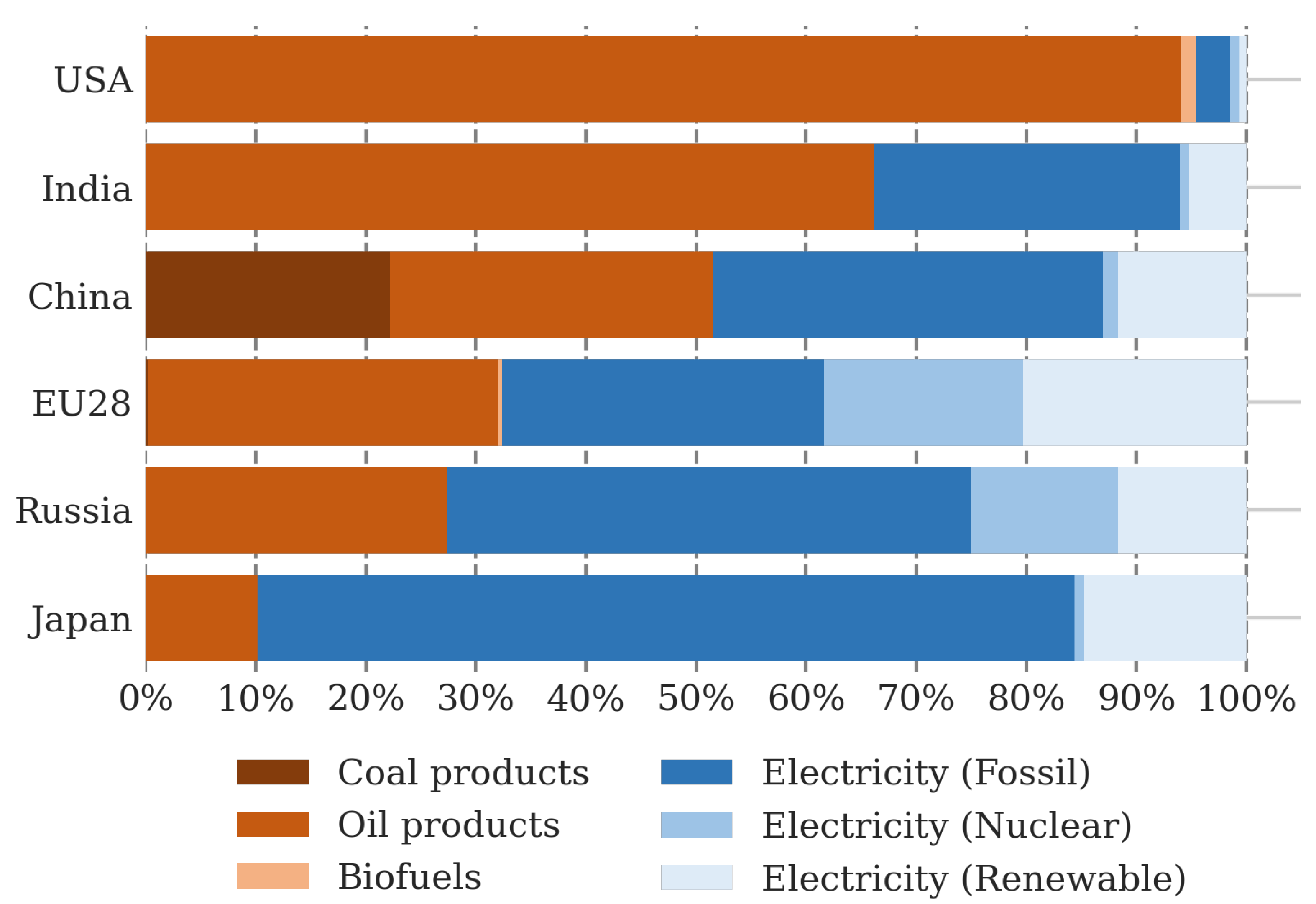
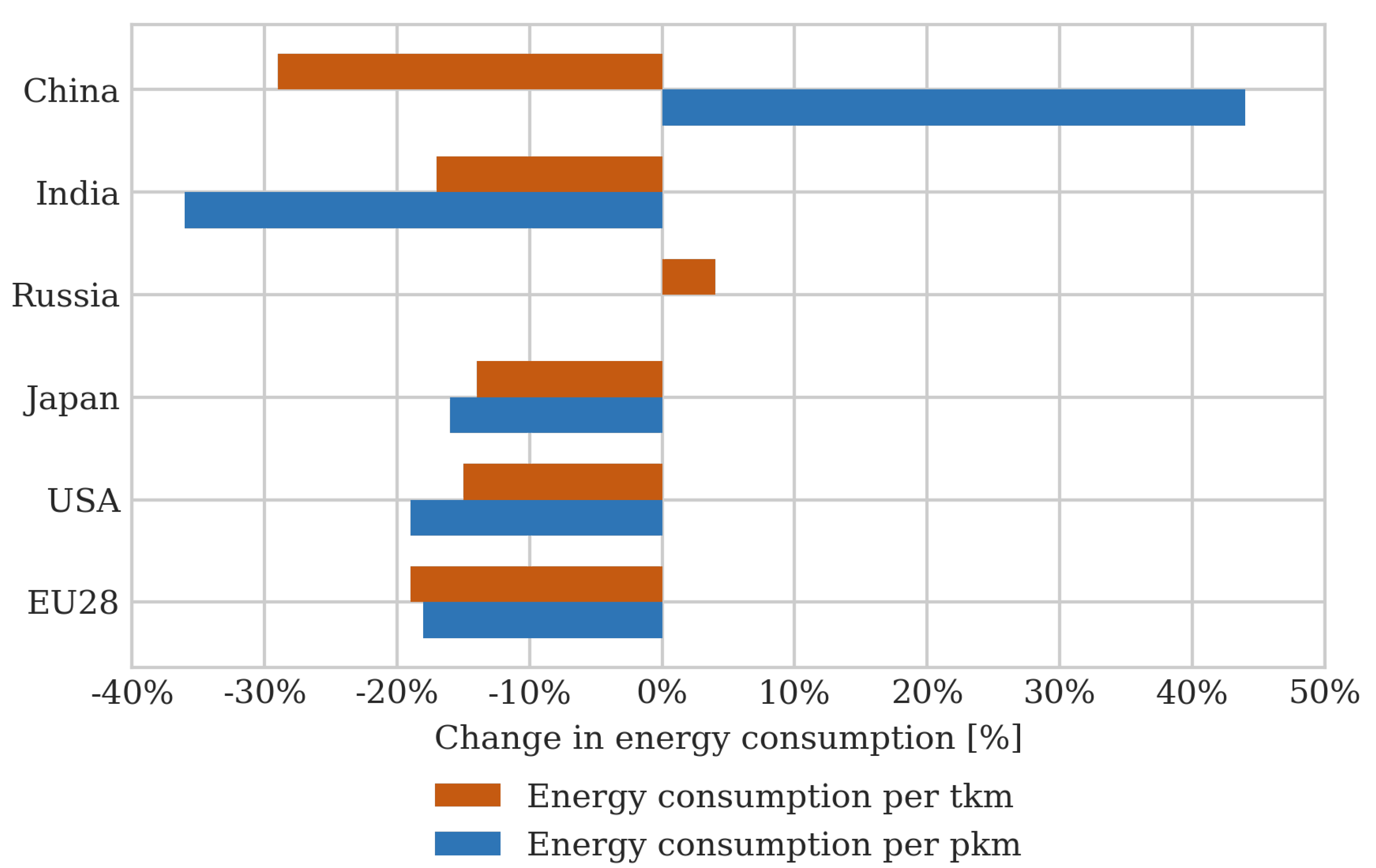

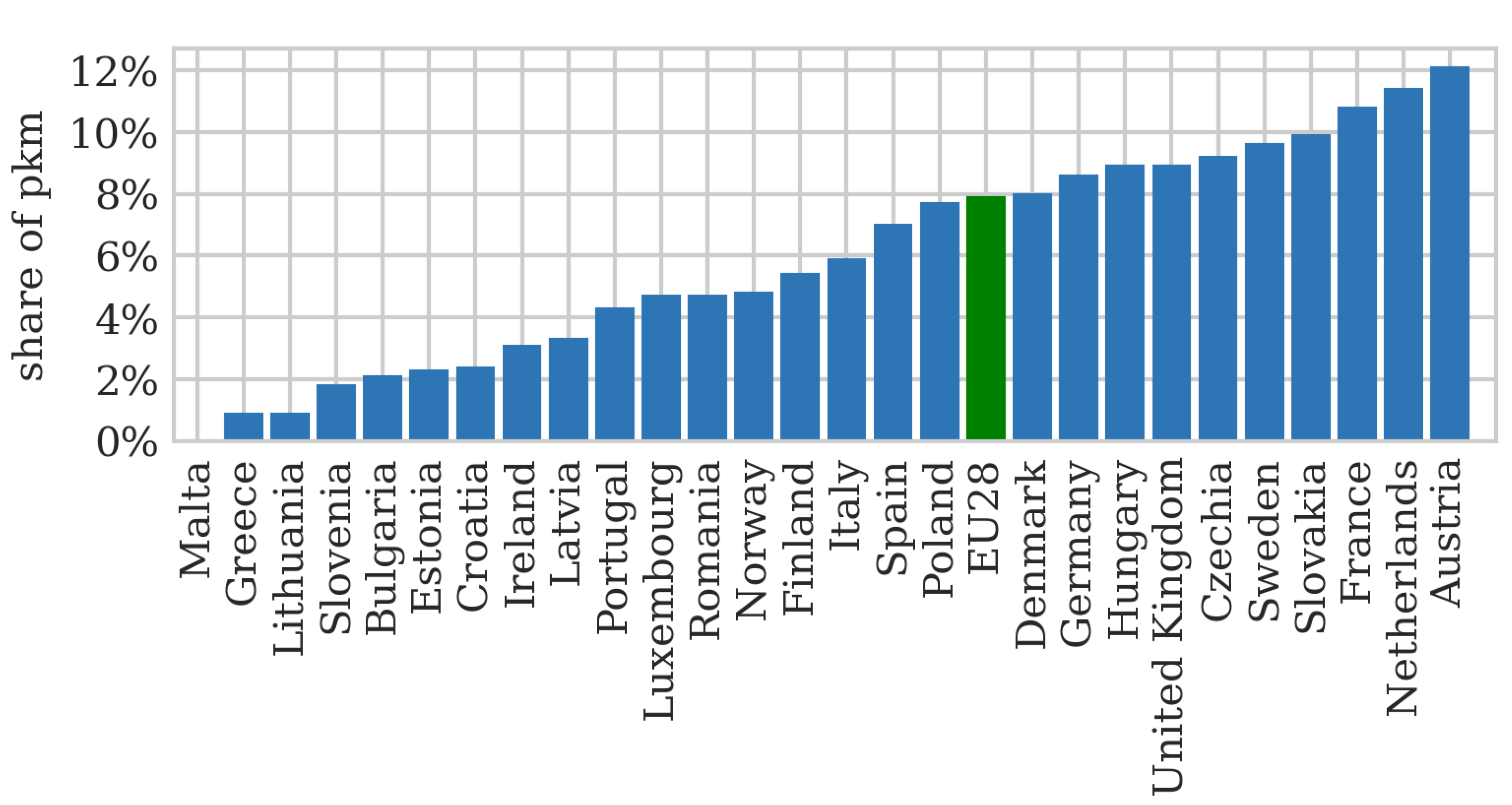
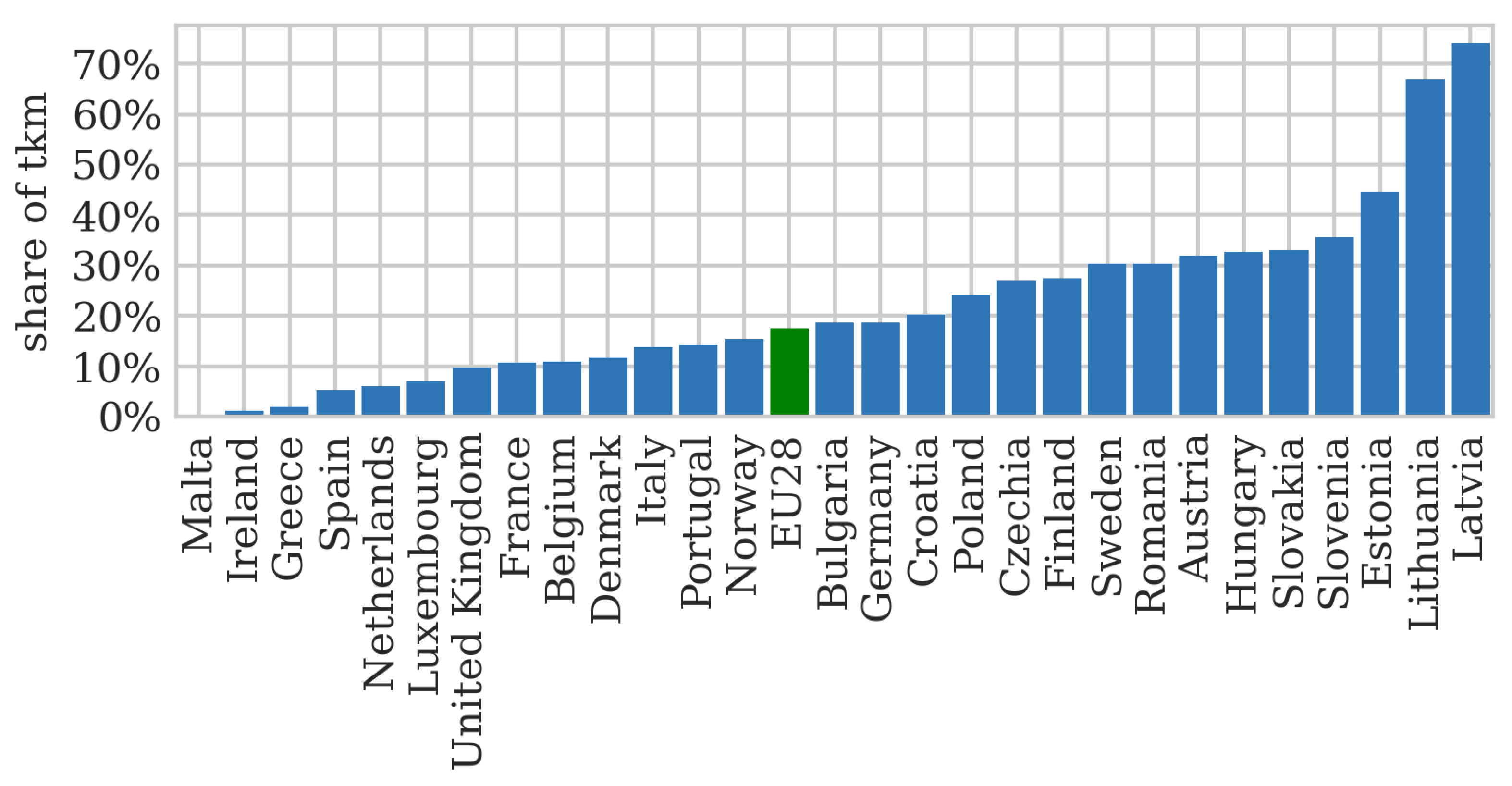

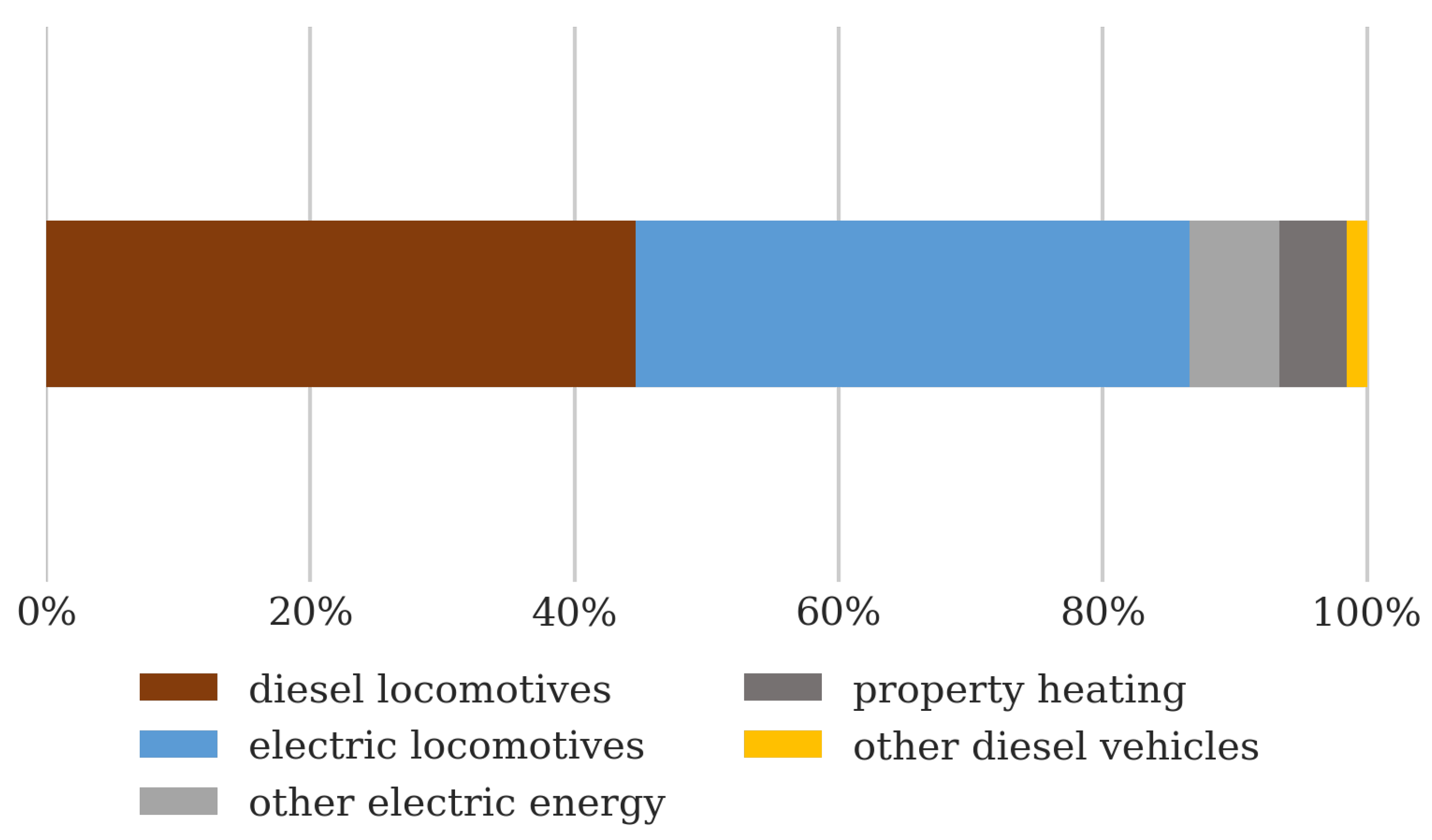
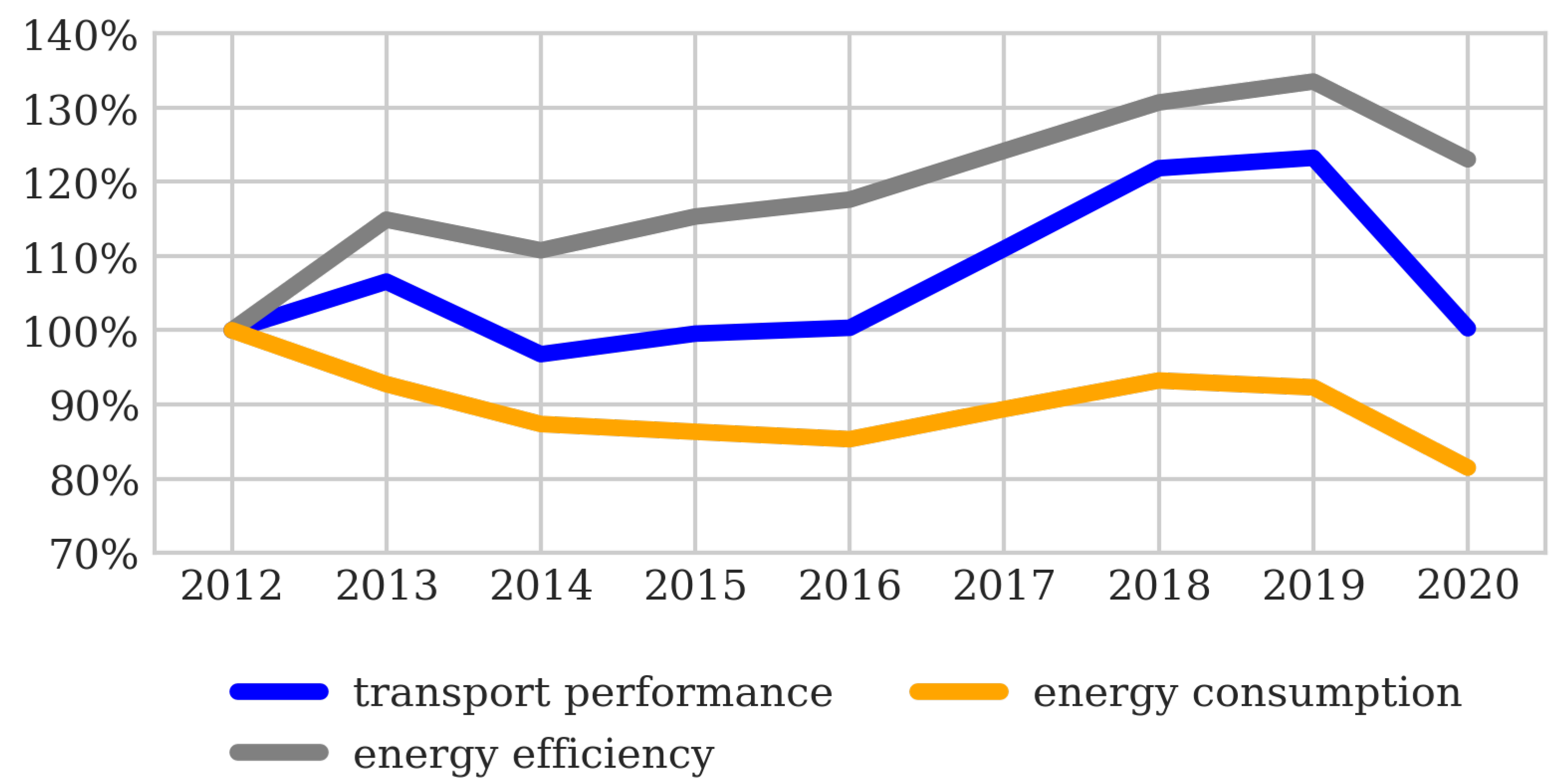

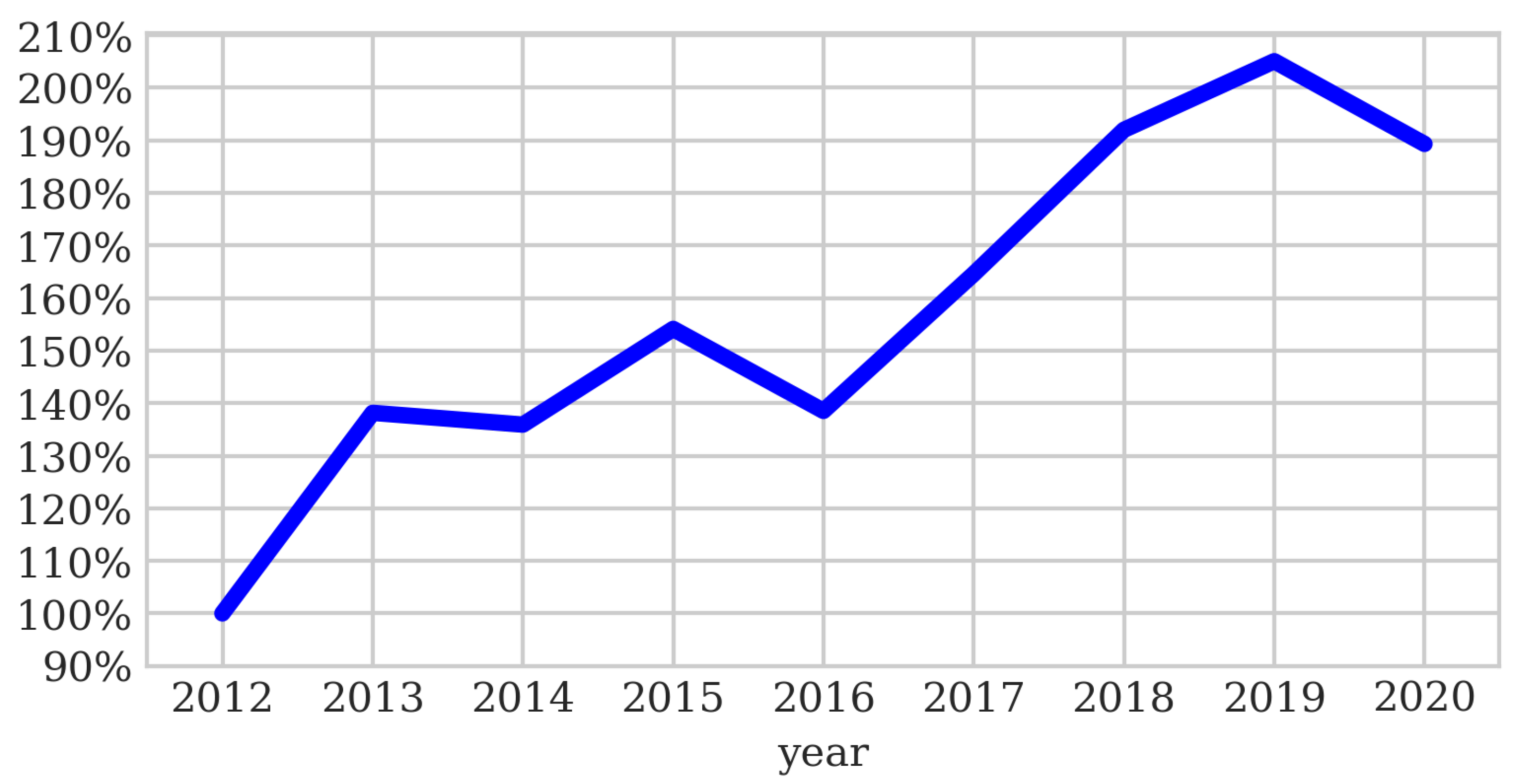
Publisher’s Note: MDPI stays neutral with regard to jurisdictional claims in published maps and institutional affiliations. |
© 2021 by the authors. Licensee MDPI, Basel, Switzerland. This article is an open access article distributed under the terms and conditions of the Creative Commons Attribution (CC BY) license (https://creativecommons.org/licenses/by/4.0/).
Share and Cite
Kuzior, A.; Staszek, M. Energy Management in the Railway Industry: A Case Study of Rail Freight Carrier in Poland. Energies 2021, 14, 6875. https://doi.org/10.3390/en14216875
Kuzior A, Staszek M. Energy Management in the Railway Industry: A Case Study of Rail Freight Carrier in Poland. Energies. 2021; 14(21):6875. https://doi.org/10.3390/en14216875
Chicago/Turabian StyleKuzior, Aleksandra, and Marek Staszek. 2021. "Energy Management in the Railway Industry: A Case Study of Rail Freight Carrier in Poland" Energies 14, no. 21: 6875. https://doi.org/10.3390/en14216875
APA StyleKuzior, A., & Staszek, M. (2021). Energy Management in the Railway Industry: A Case Study of Rail Freight Carrier in Poland. Energies, 14(21), 6875. https://doi.org/10.3390/en14216875






